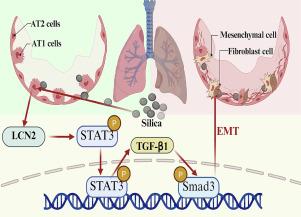LCN2-positive alveolar type II cells promote silica-induced pulmonary fibrosis via STAT3-TGF-β1-Smad3-mediated signaling
IF 3.4
3区 医学
Q2 PHARMACOLOGY & PHARMACY
引用次数: 0
Abstract
Lipocalin-2 (LCN2), an innate immune protein, has been identified as a potential biomarker in a range of inflammatory and fibrotic lung diseases. Nevertheless, its specific role and the underlying mechanisms in silica-induced pulmonary fibrosis remain unclear. This study found a significant increase in LCN2 expression in the lung tissues of silica-exposed mice during the stage of inflammation and fibrosis. The increased LCN2 was primarily derived from alveolar type II epithelial cells (AT2 cells). We further generated LCN2-overexpressing mouse AT2 cells (LCN2-OE AT2 cells) in vitro. These LCN2-OE AT2 cells exhibited significant upregulation of TGF-β1 and activation of Smad3, promoting the epithelial-mesenchymal transition (EMT) process. Additionally, exposure to silica in vitro led to an increase in the TGF-β1-Smad3 pathway and EMT process in AT2 cells. However, this response was effectively decreased when combined with an LCN2 inhibitor. Our findings highlight the significance of LCN2 originating from AT2 cells in both EMT and silica-induced pulmonary fibrosis, indicating a potential new treatment strategy for pulmonary fibrosis targeting LCN2.

lcn2阳性肺泡II型细胞通过STAT3-TGF-β1- smad3介导的信号传导促进二氧化硅诱导的肺纤维化。
脂载蛋白2 (Lipocalin-2, LCN2)是一种先天免疫蛋白,已被确定为一系列炎症性和纤维化性肺部疾病的潜在生物标志物。然而,其在二氧化硅诱导的肺纤维化中的具体作用和潜在机制尚不清楚。本研究发现,在硅暴露小鼠的炎症和纤维化阶段,肺组织中LCN2的表达显著增加。增加的LCN2主要来源于肺泡II型上皮细胞(AT2细胞)。我们进一步在体外培养了过表达lcn2的小鼠AT2细胞(LCN2-OE AT2细胞)。这些LCN2-OE AT2细胞表现出TGF-β1的显著上调和Smad3的激活,促进了上皮-间质转化(EMT)过程。此外,体外暴露于二氧化硅会导致AT2细胞中TGF-β1-Smad3通路和EMT过程的增加。然而,当与LCN2抑制剂联合使用时,这种反应有效地降低了。我们的研究结果强调了起源于AT2细胞的LCN2在EMT和二氧化硅诱导的肺纤维化中的重要性,表明了针对LCN2的肺纤维化的潜在新治疗策略。
本文章由计算机程序翻译,如有差异,请以英文原文为准。
求助全文
约1分钟内获得全文
求助全文
来源期刊
CiteScore
6.80
自引率
2.60%
发文量
309
审稿时长
32 days
期刊介绍:
Toxicology and Applied Pharmacology publishes original scientific research of relevance to animals or humans pertaining to the action of chemicals, drugs, or chemically-defined natural products.
Regular articles address mechanistic approaches to physiological, pharmacologic, biochemical, cellular, or molecular understanding of toxicologic/pathologic lesions and to methods used to describe these responses. Safety Science articles address outstanding state-of-the-art preclinical and human translational characterization of drug and chemical safety employing cutting-edge science. Highly significant Regulatory Safety Science articles will also be considered in this category. Papers concerned with alternatives to the use of experimental animals are encouraged.
Short articles report on high impact studies of broad interest to readers of TAAP that would benefit from rapid publication. These articles should contain no more than a combined total of four figures and tables. Authors should include in their cover letter the justification for consideration of their manuscript as a short article.

 求助内容:
求助内容: 应助结果提醒方式:
应助结果提醒方式:


